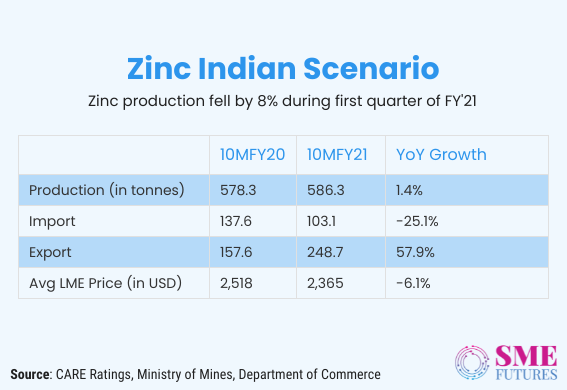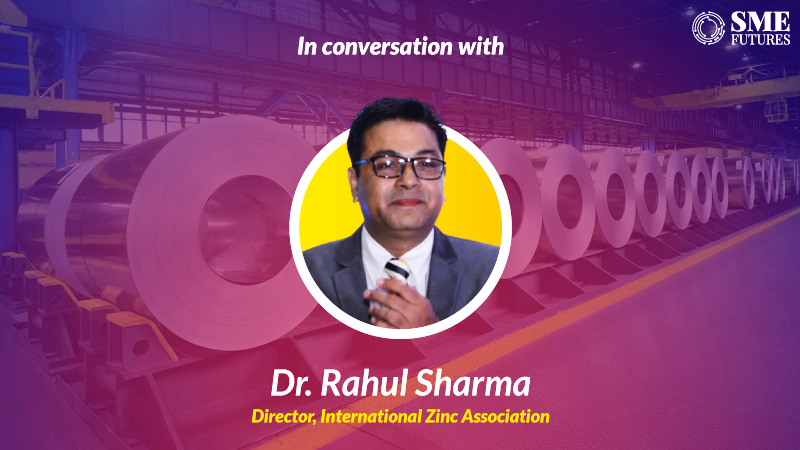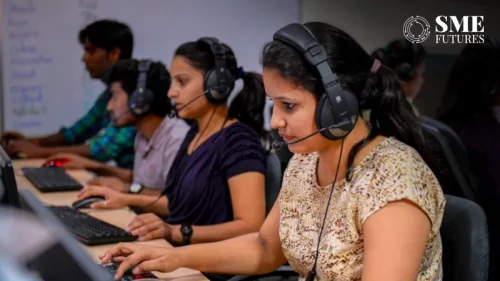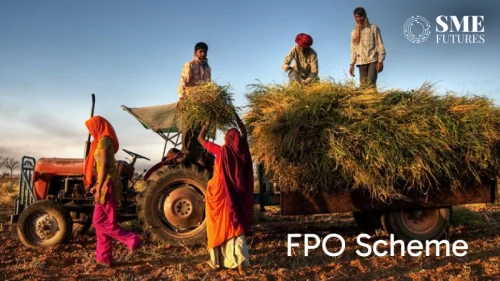Zinc production and its allied sectors are an important industry for India. In financial year 2017, the volume of zinc production in India amounted to approximately 1.48 million metric tonnes. However, production went down to around 0.37 million metric tonnes in the fiscal year 2020. At the same time, according to the Indian Zinc Association (IZA), despite having a zinc surplus, India is lagging China in the zinc die casting market, which is considered an MSME in India.
Following the pandemic outbreak in India, the zinc die-casting sector, like any other industry, has been impacted as an MSME. Currently, Indian zinc die caster players are witnessing a huge down slide in market demand, creating several other challenges for the businesses in this sector.
“Surge in global commodity and fuel prices have had serious implications for players like us, given that we must bear the financial brunt of it all. For the zinc die-casting sector, wherein most of the players are in the micro and small-scale category and who are already burdened with limited credit access and lack of technical knowhow, the second wave has exacerbated its challenges,” says Dr. Rahul Sharma – Director, International Zinc Association. However, with new government infrastructure plans, recovery in steel production and demand, FY22 is likely to usher in a higher demand for zinc.
In a one-on-one conversation with SME Futures, Dr. Sharma further discusses the overall impact of COVID-19 on the Indian zinc die casting industry.
Edited Excerpts–
What is the size of India’s zinc die casting industry? What is the outlook for the sector?
As per the market analytics, the global die-casting market size is predicted to reach over US$ 100 billion by 2028. The global die casting industry has attracted the automotive sector and hardware sectors including the piping and sanitary wares industries have also started employing die casting.
The Indian zinc die casting industry consumes approx. 1.5 lakh tonnes per annum. This includes the consumption of virgin and recycled zinc alloy.
If we compare our present status to other developing nations like China, India lags tremendously despite having a zinc surplus. China has a 50 per cent plus market share worldwide against 6 per cent for India, which is miniscule. China employs 15 million people in the zinc die-casting space as compared to a few lakhs by India.
Globally, 18 per cent of the zinc produced gets absorbed for zinc die casting – a popular manufacturing process used in the automobile, bathroom, and sanitary ware segment. However, only 8 per cent of the zinc gets consumed for die-casting in India which is far below the world average. While there have been small enterprises and MSMEs exporting zinc and related raw material to global markets, the quantity and quality is far behind global requirements. This indicates the upside potential, if we let this industry find its foothold.

What has been the pandemic’s impact on the zinc sector, and how has it affected your business? Are there any specific zinc manufacturers or MSME players with whom you have a close working relationship that have been impacted?
With the COVID-19 crisis forcing blanket lockdowns across the nation, the overall economy has taken a massive hit. The pandemic has capsized businesses across sectors, presenting them with unprecedented challenges and forcing them to adapt and re-invent themselves to survive and thrive.
Because of the COVID pandemic, MSMEs have been severely affected and their business has come to standstill. These MSMEs employ a large number of labourers and because of the lockdowns, they migrated to their native places, thus creating an acute labour shortage when the unlock took place. These are hiccups that this sector is not ready to face and thus it is severely impacting their business. As an association, we know a large number of zinc die casting companies and their businesses have been impacted. However, those doing 100 per cent export are the least affected because of the lockdown.
For the zinc die-casting sector, the impact has been no different than what most other sectors have felt due to the pandemic.
While we are an independent industry association, we counsel and work closely with zinc die-casting players including DST Tech Private Limited. For this sector, domestic market orders have reduced by nearly 80 per cent. Domestic payments for supplies made before the imposition of the lockdowns have been affected to the extent of 40 per cent. Moreover, a further surge in global commodity and fuel prices have had serious implications for not just the economy but for players like us too. Given that we must bear the financial brunt. So, the zinc die-casting sector, wherein most of the players are in the micro and small-scale category, and who are already heavily encumbered with limited credit access and lack of technical knowhow, the second wave has exacerbated their challenges.
What are the critical policy measures you seek as the apex body of the zinc sector to promote the growth of the industry and businesses associated with zinc?
The International Zinc Association operates internationally and locally through its regional affiliates. We help sustain the long-term global demand for zinc and its markets by promoting such key end uses as corrosion protection for steel and the essentiality of zinc to human health and crop nutrition. We work very closely with governments to formulate policy on sustainable development in the most eco- friendly ways.
One of our major works is in the space of boosting sustainable infrastructure by using the right technologies like galvanization. Galvanised steel and hot-dip galvanised corrosion-resistant rebars have been used for more than 100 and 50 years respectively, especially to protect structures exposed to different exposure conditions from corrosion. Realising the importance of this technique, the Honorable Prime Minister Narendra Modi has outlined a plan to spend about $1.5 trillion, to upgrade and build infrastructure over the next five years to shore up economic growth, boosting the outlook for zinc and the use of galvanised steel to prevent corrosion. While it is a promising step, enforcement and mandating the right standards is the need of the hour.
Additionally, awareness about the benefits and applications of zinc die-casting amongst manufacturers, engineers, designers, policy makers and the government is key for the growth of this sector. Organisations like the International Zinc Association are dedicated to increasing awareness of zinc casting alloys among engineers, designers and specifiers through technology transfer, technical services, and designer education programs. It is only when organisations like us work with the government that the sector can tap into its actual potential.
For the fastest growing country that is aiming to be a 5 trillion-dollar economy by 2024, India’s economic growth is intricately linked to the growth of the steel industry. The application of the right kind of construction technology along with galvanised steel usage will ensure the long life, safety, and security of the public.

What are the challenges that MSMEs in the zinc die casting industry face, and how can the government help them to overcome them?
The second wave is bigger than the first in terms of impact. The government should come up with a good package to handhold MSMEs/ SMEs and improve their financial health. Financial institutions too should start giving loans based on the projected balance sheet of companies and not focus on business in the past 1-2 years, which was anyway impacted by the slowdown and COVID-19.
Conducive policy reforms must also mean ease of credit access for MSMEs. Banks and NBFC’s will play a major role in facilitating easy financing for the sector. Incentives for banks focusing and innovating with lending strategies to MSMEs must be incorporated on a structured long-term basis. The sector needs to be positioned as a core business activity for these banks. Also, the fintech sector can be tapped into to provide unsecure loan offers to players in the MSME sector.
A targeted approach towards the specific sectors will be essential. For example, new frameworks for financing for manufacturing start-ups such as those in the zinc industry can be looked at, as the gestation period for setting up such industries is much higher than that for the service start-ups.
Additionally, private sector support does (and will continue to) play a huge role in ensuring the growth of the SME sector. Take a cue from technology leader Mastercard which recently announced an additional investment of Rs 2.5 billion to help small businesses in the country to go digital and have easy access to credit. Apart from fund support, corporates can also help SMEs with supplier development for future scalability and competitive advantage. The financial sector can also drive uptake and capacity-building in new channels and payment methods.
How has funding or finance been a challenge for the sector’s MSMEs?
Complete stoppage of production due to the national lockdown during the first wave, regional lockdowns during the second wave and reduced financial flow in the informal money market have adversely affected the operations and output of registered and informal SMEs.
Making matters worse, MSMEs and SMEs have faced issues with respect to the piling up of loan repayments as financial institutions are not offering any respite to them. Getting further credit has also become an issue. The Government of India has given INR 1CR as collateral free loans through banks for SMEs. However, for a “stand-up SME” in the manufacturing sector such as us, whose funds requirements are higher than Rs 1 crore, traditional banking based on “collateral funding” cannot work. Moreover, banks were not very forthcoming in disbursing credit.
In 2020, the government announced a plan to spend around $1.5 trillion on infrastructure; how has this helped the industry? And how has the work been progressing?
The government had announced the package to extend relief to businesses. I am sure that this package of $1.5 trillion for infrastructure will boost demand and will act as a prime mover for MSMEs. In every infrastructure project, many items produced by these MSMEs get used and thus helps them and makes them economically viable to sustain.
Also, the government’s push for the modernisation of airports and the Central Vista Project will further catalyse demand and help MSMEs in a big way. Moreover, this sector employs a lot of people from rural areas, thus creating rural demand for several items.
Because of the second wave and the recent lockdown, this sector has been impacted tremendously and everyone is eagerly waiting for the return of normalcy. Hopefully, because of aggressive vaccination, we might not have to face the third wave of COVID. The MSME sector will bounce back strongly once normalcy gets restored.











